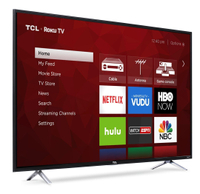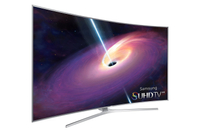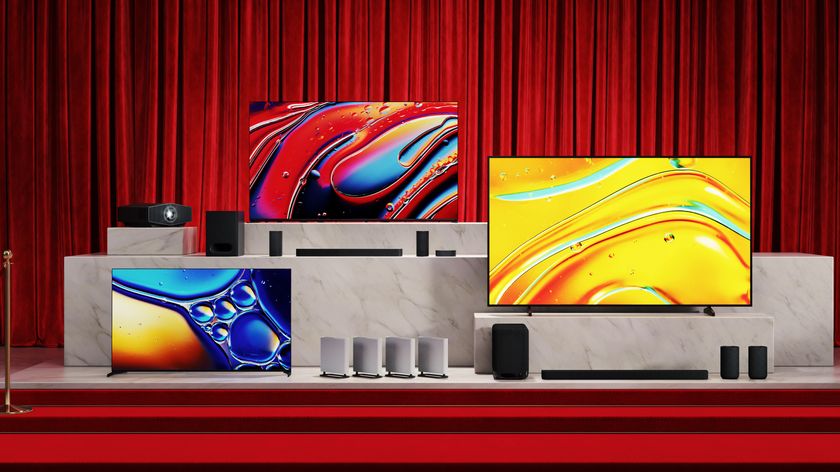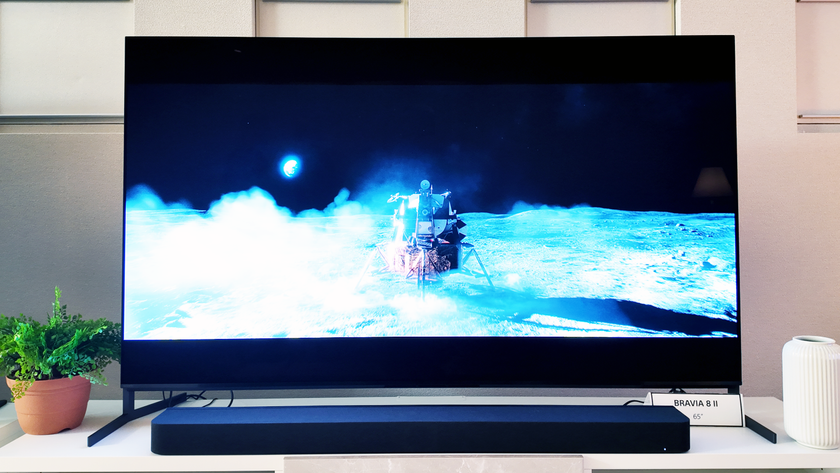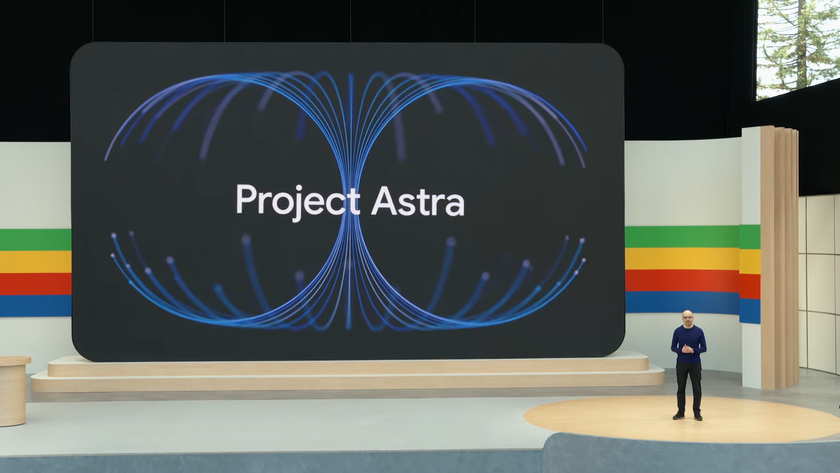What Is HDR TV, and Why Does It Matter?
If you want true-to-life color, you’ll want your next TV to support HDR. Here’s everything you need to know.
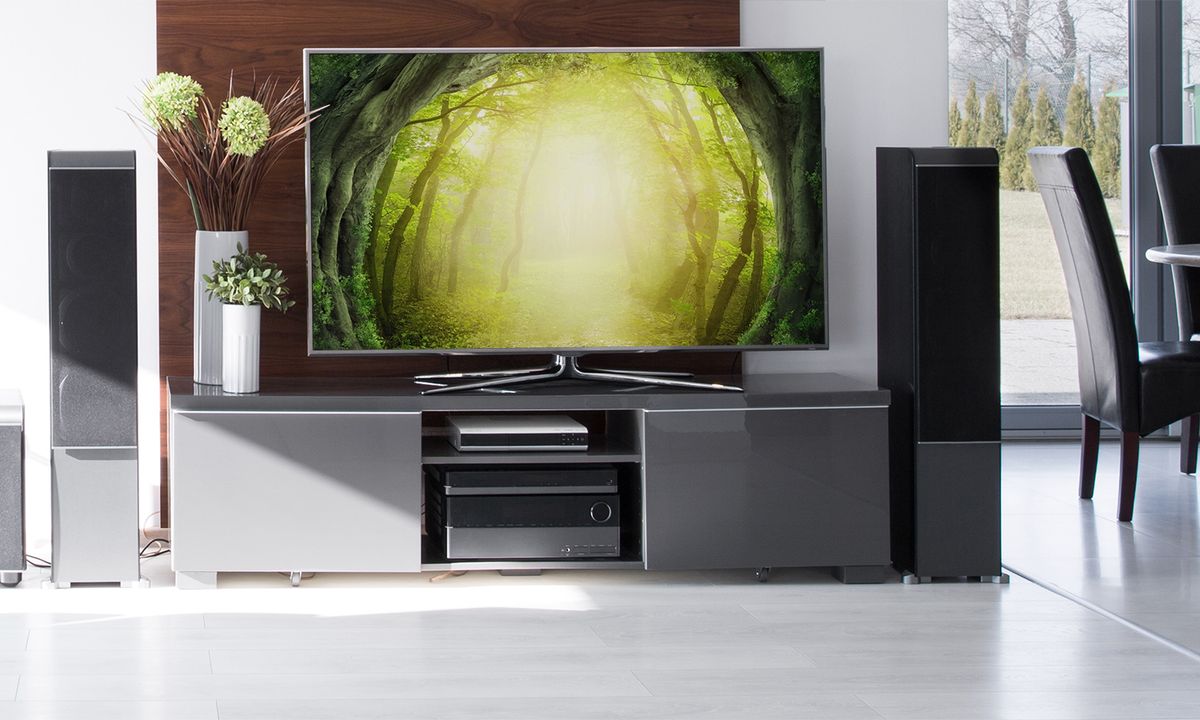
Every year, TV makers engage in a game of one-upmanship and try to create the perfect TV. The quest for the perfect picture is now focused on HDR, which promises to deliver more realistic colors and shades to create a true cinematic experience at home. HDR is still a nascent technology, so to sort out what it means to shoppers now, here are all the answers you need to know before you buy.
What does "HDR" stand for?
"HDR" stands for "high dynamic range," which refers to its ability to deliver more colors, better contrast levels and increased brightness compared with standard HD and even 4K Ultra HD sets. HDR is essentially an upgrade of the 4K or Ultra HD format. (It is not applicable to 1080p HD sets.)

Though many LCD TVs could physically produce a wide range of colors (known as the color gamut), they were limited by an outdated video specification (known as Rec. 709). HDR was introduced to rectify the situation by broadening the number of colors a TV would be allowed to display and by increasing the brightness or intensity of those colors. Essentially, HDR allows new LCD and OLED to reach their full potential.
Will I notice a difference when watching HDR content?
If you're watching an HDR movie or show on an HDR TV, yes, you will definitely see an improvement. It can make invisible faces in a dark scene visible and eliminate the kind of annoying color banding that occurs between shades of colors as an image makes the transition, for example, from orange to red in a sunset.
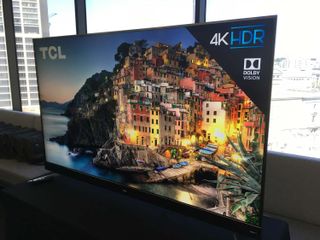
On the other hand, some less-expensive HDR-capable TVs, such as TCL's 55-inch 4K Roku TV with HDR, may meet only the minimum requirements of the specifications, so the differences may not be as drastic on those sets. In other words, not all HDR sets are created equal.
Furthermore, as DisplayMate President Raymond Soneira pointed out, not all content is worth the HDR treatment. For example, HDR 4K video is impressive in jungle scenes, but not all video material contains the same level of color saturation as a bright-green frog sitting on a red leaf.
Another important factor in our perception of the realism of a video image is the frame rate of the video. Ultra HD Premium TVs support rates from 24 frames per second (like film) to 120 fps. At 120 fps, video looks much more solid, and there's less blurring of fast-moving objects, such as cars racing in a chase scene or someone trying to steal second base. So the picture quality depends on the frame rate of the HDR program. However, there is no native 120-fps programming available — yet.
To watch HDR programs, what do I need?
Before you watch a movie on your TV, the film is compressed from its original color range to fit into the old video format, essentially eliminating subtle shades, contrast and image depth. In theory, HDR restores some of that lost color and contrast, but it requires remastering the original show — in essence, producing a new version of the movie or program.
So, to get the full benefit of HDR, you must have not only a compatible TV but also access to HDR content and programming.
What HDR content is available?
Only a handful of 4K HDR programs are currently offered on streaming services from Netflix, Vudu and Amazon. YouTube also has a few compatible programs, and some services even have a few Dolby Vision HDR shows. And, confusingly, Amazon is promoting a format supported by Samsung called HDR10+. (More on all these formats below).

But the HDR pickings are still thin. Netflix has released some of its original programming in HDR, such as Girlboss,The OA, and movies such as The Do-Over. Amazon offers shows such as Mozart in the Jungle and Red Oaks to Prime members in HDR; some programs, like Bosch - Season 2, support both HDR10 and Dolby Vision.
To get the full HDR streaming picture, ideally you should have a 15-Mbps or faster internet connection. Because most viewers lack such connection speeds, playing 4K Ultra HD Blu-ray HDR discs may be a better alternative. However, HDR discs have been slow to appear, and they are expensive. The HDR 4K version of The Martian is $30. About 20 major movie titles supporting HDR and Dolby Vision are available, including The Lego Movie, The Martian, Mad Max: Fury Road, The Man from U.N.C.L.E., American Sniper, Man of Steel and Edge of Tomorrow.
MORE: Best 4K HDR Blu-ray Movies on Amazon
Most HDR-compatible discs, such as the one for Power Rangers, are labeled "4K Ultra HD" with an additional "HDR" sticker. To play such Blu-ray discs in HDR mode, you need a compatible player, such as the Oppo UDP-205 4K Ultra HD Audiophile Blu-ray Disc Player, which can also play Dolby Vision HDR discs.
How do I know if a TV is HDR-compatible?
Although there are efforts to standardize on a single HDR specification, currently, there is no single, universally agreed-upon HDR spec.
"There is definitely a bit of a format war going on at present," said Paul Gray, a principal analyst and researcher at market research firm IHS.
TV manufacturers tout several HDR formats that indicate a TV is HDR-ready:
Ultra HD Premium: Established by the UHD Alliance, this standard is backed by dozens of companies, including movie studios and TV makers. It applies mainly to TVs and forthcoming 4K Blu-ray players, and sets a minimum specification for sets, which allows them to stick the iridescent Ultra HD Premium logo on the box.
Dolby Vision: Created by the surround-sound folks, Dolby Vision lays out a set of specifications that stretch from movie production, to broadcast TV, to the televisions that can play Dolby Vision HDR material. In some respects, Dolby Vision sets a higher technical standard for HDR than Ultra HD Premium, although not all Dolby Vision-labeled sets meet the maximum specifications.
HDR10: HDR10 is the same as Ultra HD Premium when it comes to playing HDR programming. However, HDR10, unlike Dolby, does not specify that a particular encoding system must be used for movies, so that battle in Hollywood may continue for some time.
Hybrid Log Gamma (HLG): Adding data to broadcast signal is a big hurdle to providing HDR content over the air, or even via cable and satellite, since distribution is optimized for SDR TVs. To overcome this hurdle, Japan's NHK and Britain's BBC teamed up to create a broadcast-friendly version of HDR. The result is Hybrid Log Gamma (HLG) which is a part of the ATSC 3.0 standard, the next-gen broadcasting technology coming to TVs sometime in the future – it's been in development for a few years already, but isn't widely available. Virtually all current 4K TVs support HGL signal, but content is sparse; there have been select live events, like hockey games and live concerts featuring HLG, but it's still early days for this format.
HDR10+: A standard (supported by Samsung and Amazon) based on HDR10, but with the addition of Dynamic Tone Mapping, which includes metadata for specific scenes, rather than just the movie as a whole (as with HDR10). This feature makes HDR10+ closer in performance (in theory) to Dolby Vision.
Technicolor Advanced HDR: Technicolor's own HDR format comes in two forms, one for broadcast TV and another for Ulta HD media, like 4K Bluray. The first, called Single-Layer HDR1 (SL-HDR1), packages HDR data into an SDR video signal, making is easier and cheaper for TV broadcasters to provide HDR content for over-the-air signal without having to broadcast two separate signals. The other component of Advanced HDR is SL-HDR2, which adds dynamic HDR metadata to 4K media. With HDR10 as a base, this additional metadata adds dynamic scene-by-scene information for better contrast and color.
So far, Technicolor Advanced HDR is only supported by current LG TV models, but may expand to include Philips and Maganvox TVs later this year.
IMAX Enhanced: The latest specification to hit the market is IMAX Enhanced, which goes above and beyond HDR content information to also include standards for audio and support for unique aspect ratios. Aspect ratios are an especially big deal for IMAX content, which uses 1.9:1 or 1.43:1 aspect ratios, which many TVs do not support. With both video and audio aspects to the standard, IMAX Enhanced is competing primarily with Dolby Vision and Dolby Atmos, but the HDR elements of the standard are based on HDR10. So far the only manufacturer to offer IMAX Enhanced support is Sony, but more manufacturers might hop onboard in the coming months.
| HDR Format | Supported By |
| Dolby Vision | LG, Philips, Sony, TCL, Vizio |
| Ultra HD Premium | LG, Philips, Samsung |
| HDR10 | Hisense, LG, Panasonic, Philips, Samsung, Sony, Vizio |
| HDR10+ | Samsung, Amazon |
| Technicolor Advanced HDR | LG |
| IMAX Enhanced | Sony |
HDR is still in its infancy, so there is no conclusive winner yet. However, Dolby Vision is picking up more support. LG, Sony and Vizio, for example, all have Dolby Vision-compatible TVs.
The good news is that whatever HDR set you buy today will be backward-compatible. In other words, all HDR TVs will upscale or convert regular HD content to display on their screens. However, the picture improvement won't be as profound as what you'll see with true HDR content.
What's the difference between Ultra HD Premium and Dolby Vision?
Some TVs are Ultra HD Premium-compatible (like Samsung), others are Dolby Vision-compatible (like Vizio) and some are compatible with both (like LG). So what's the difference?
Ultra HD Premium establishes several general capabilities that TVs have to possess to be HDR-compatible. There are a variety of components, including audio requirements, the already-established 3840 x 2160-pixel Ultra HD resolution and the elimination of an interlaced picture (the "i" in 1080i). But the primary changes involve color and brightness/contrast. Ultra HD Premium sets the color depth to a 10-bit signal (versus the current 8-bit depth) and minimum peak brightness at 1,000 nits (with an exception for sets that can produce true black, and therefore more contrast, like OLED models).
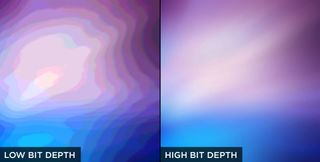
For comparison, HD and Blu-ray video use 8-bit color for a possible total color palette of roughly 16.7 million shades. Moving up to 10 bits yields well over a billion possible colors.
An Ultra HD Premium TV also has to be able to reproduce more than 90 percent of a color spectrum specification that is called DCI-P3. Also known as the color gamut, it's the total possible range of colors a video or TV can produce. DCI-P3 is from the Digital Cinema Initiative, whose spec is used for the movies you see in theaters. That makes it an obvious choice — and a big improvement — over the limited Rec. 709 format. (There is another even wider proposed color scheme, Rec. 2020, but current TVs are not capable of displaying all of its colors, and new digital movies would have to be shot in the format.)

Dolby Vision contains more HDR-format details, but for consumer televisions, it also emphasizes color reproduction and brightness. Dolby requires a 12-bit color depth, with a possible 68 billion shades. As Soneira said, "8-bit is awful, 10-bit is good and 12-bit is what you need."
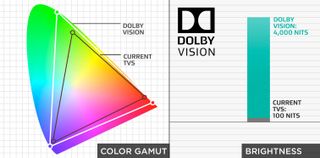
Dolby Vision also sets the brightness bar higher, requiring levels of 4,000 nits or more. The catch is that, while TVs with the Dolby Vision logo are certified by Dolby, not all Dolby-certified sets meet all of the specifications. In other words, many sets won't meet that 4,000-nit mark, including OLED TVs. However, LG's sets are officially Dolby Vision-compatible and certified.
So, which is better — Ultra HD Premium or Dolby Vision?
Based on the specs alone, it would appear that Dolby Vision TVs would deliver a better HDR picture than Ultra HD Premium TVs. And a set that's Dolby Vision-compatible should also be able to handle the lesser requirements of Ultra HD Premium.
MORE: The New 4K Format War: Read This Before You Buy
However, that may not always be the case. Manufacturers that don't choose to license Dolby Vision technology may nevertheless make TVs that exceed the HDR capabilities of Dolby-labeled TVs. That means that there may be sets with an Ultra HD Premium sticker that look superior to other models with a Dolby Vision label. (That doesn't even account for the differences between, for example, OLED and LCD sets.)
Can my TV be upgraded to HDR?
A few TVs can be upgraded to handle HDR programs. Most of the sets that can do so are recent top-of-the-line models, and they require a software download (usually done easily over the TV's existing Wi-Fi connection).
Samsung's 2015 UN65JS9500 (about $4,000) is one example of a set that can be upgraded via a software download. It already had the technical ability to meet the Ultra HD Premium specifications. Samsung says other 2015 sets may also be upgradable.
However, some confusion is bound to ensue among shoppers as TV makers claim that some 4K Ultra HD sets are "compatible" with HDR content but won't be able to meet the Ultra HD Premium specification. In other words, these sets will be able to play HDR video but not reproduce all of the available colors or brightness levels.
What comes after HDR? Should I wait for 8K?
As TV makers and movie studios get accustomed to the new format, better TVs and more finely crafted HDR-mastered movies are bound to appear. However, today's TVs are better than yesterday's TVs, so there's no reason to avoid buying a set.
For several years, there has been discussion about, and experimentation with, so-called 8K televisions delivering double the number of pixels as 4K Ultra HD. However, it's never gone beyond experimentation.
MORE: Our Favorite 4K (Ultra HD) TVs Available Now
"The big problem is not making the displays," Gray said. The problem is that the data rate necessary to transmit 8K is "gigantic," he added. Not to mention, an 8K set would have to be giant for viewers to appreciate all of those extra pixels.
Should I get a TV with HDR?
HDR is gaining momentum among TV manufacturers, and it looks destined to become standard in top-performing 4K sets. Moreover, HDR content clearly looks brighter, punchier and more impressive than basic 4K or HD fare. So while there's still a dearth of HDR programming available, a little foresight will tell you that choosing a set that can handle HDR now is a wise decision.
Credit: Tom's Guide
Sign up to get the BEST of Tom's Guide direct to your inbox.
Get instant access to breaking news, the hottest reviews, great deals and helpful tips.
John R. Quain has been reviewing and testing video and audio equipment for more than 20 years. For Tom's Guide, he has reviewed televisions, HDTV antennas, electric bikes, electric cars, as well as other outdoor equipment. He is currently a contributor to The New York Times and the CBS News television program.
